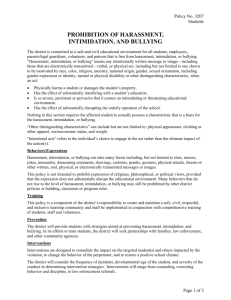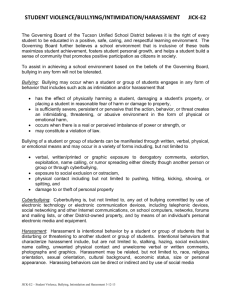Bullying Policy - Fairland Local School District
advertisement
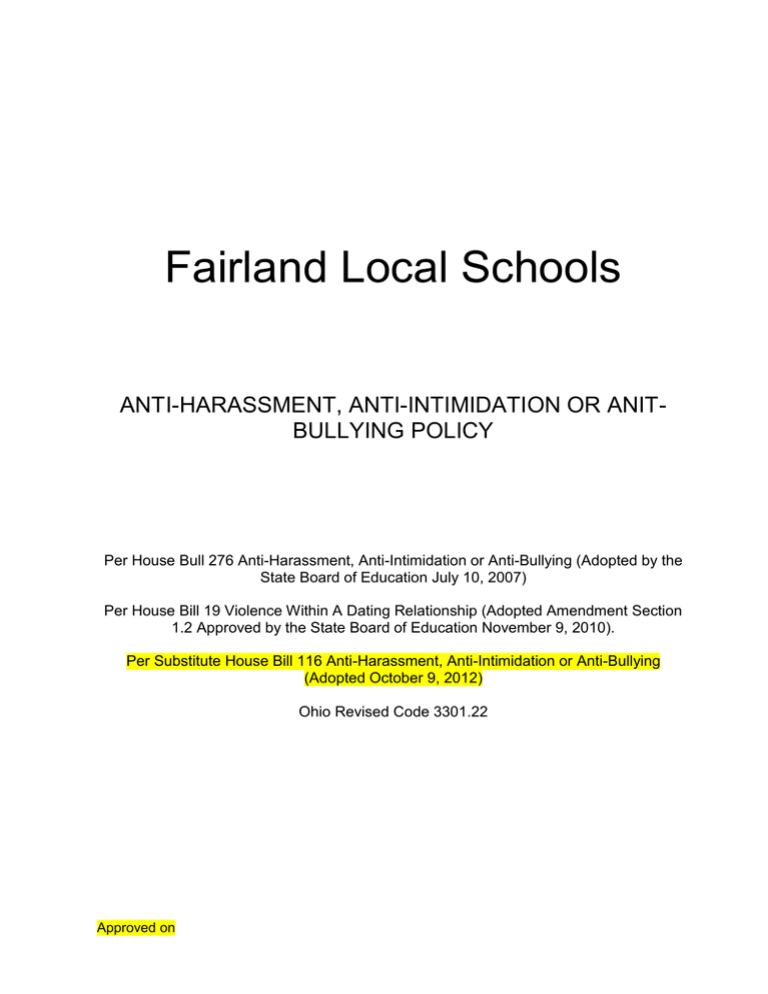
Fairland Local Schools ANTI-HARASSMENT, ANTI-INTIMIDATION OR ANITBULLYING POLICY Per House Bull 276 Anti-Harassment, Anti-Intimidation or Anti-Bullying (Adopted by the State Board of Education July 10, 2007) Per House Bill 19 Violence Within A Dating Relationship (Adopted Amendment Section 1.2 Approved by the State Board of Education November 9, 2010). Per Substitute House Bill 116 Anti-Harassment, Anti-Intimidation or Anti-Bullying (Adopted October 9, 2012) Ohio Revised Code 3301.22 Approved on Table of Contents 1. Definition of Terms……………………………………………….1 2. Types of Conduct………………………………………………...2 3. Complaint Process……………………………………………….2 4. Complaints………………………………………………………..3 4.1Formal Complaints…………………………………………...3 4.2 Informal Complaints…………………………………………4 4.3 Anonymous Complaints…………………………………….4 4.4 False Reporting……………………………………………...4 5. School Personnel Responsibilities and Intervention Strategies………………………………………………………4 5.1 Teachers and Other School Staff………………………….4 5.2 Administrator Responsibilities……………………………...5 5.3 Intervention Strategies………………………………………7 6. Reporting Obligations……………………………………………8 7. Police and Child Protective Services…………………………..9 8. Training……………………………………………………………9 It is the policy of Fairland Local School District that any form of bullying behavior, whether in the classroom, on school property, to and from school, on a school bus or at school-sponsored events, is expressly forbidden. 1. Definition of Terms 1.1. Harassment, intimidation or bullying” means either of the following: 1.1.1. Any intentional written, verbal, graphic, or physical act that a student or group of students exhibited toward other particular student more than once and the behavior both: 1.1.1.1. Causes mental or physical harm to the other student; and 1.1.1.2. Is sufficiently severe, persistent or pervasive that it creates an intimidating, threatening or abusive educational environment for the other student. 1.1.2. Violence within a dating relationship. 1.1.3. By Electronic Means 1.1.3.1. “Electronic act" means an act committed through the use of a cellular telephone, computer, pager, personal communication device, or other electronic communication device. 1.2. Harassment, Intimidation or Bullying also means electronically transmitted acts i.e., Internet, cell phone, personal digital assistance (PDA) or wireless hand-held device that a student has exhibited toward another particular student more than once and the behavior both: 1.2.1. Causes mental or physical harm to the other student/school personnel; and 1.2.2. Is sufficiently severe, persistent or pervasive that it creates an intimidating, threatening or abusive educational environment for the other student/school personnel. 1.3. In evaluating whether conduct constitutes harassment, intimidation or bullying, special attention should be paid to the words chosen or the actions taken, whether such conduct occurred in front of others or was communicated to others, how the perpetrator interacted with the victim, and the motivation, either admitted or appropriately inferred. 1.4. A school-sponsored activity shall mean any activity conducted on or off school property (including school buses and other school-related vehicles) that is sponsored, recognized or authorized by the Fairland Local School District Board of Education. 1 2. Types of Conduct 2.1. Harassment, intimidation or bullying can include many different behaviors including overt intent to ridicule, humiliate or intimidate another student or school personnel. Examples of conduct that could constitute prohibited behaviors include: 2.1.1. Physical violence and/or attacks; 2.1.2. Threats, taunts and intimidation through words and/or gestures; 2.1.3. Extortion, damage or stealing of money and/or possessions; 2.1.4. Exclusion from the peer group or spreading rumors; and, 2.1.5. Repetitive and hostile behavior with the intent to harm others through the use of information and communication technologies and other Web-based/online sites (also known as “cyber bullying”), such as the following: 2.1.5.1. Posting slurs on Web sites where students congregate or on Web logs (personal online journals or diaries); 2.1.5.2. Sending abusive or threatening instant messages; 2.1.5.3. Using camera phones to take embarrassing photographs of students and posting them online; and, 2.1.5.4. Using Web sites to circulate gossip and rumors to other students; 2.1.5.5. Excluding others from an online group by falsely reporting them for inappropriate language to Internet service providers. 3. Complaint Processes 3.1. Publication of the prohibition against harassment, intimidation and bullying and related procedures. 3.1.1. The prohibition against harassment, intimidation or bullying shall be publicized in any student handbooks and in any of the publications that set forth the comprehensive rules, procedures and standards of conduct for schools and students in the district. In addition, information regarding the policy shall be incorporated into employee training materials. The following statement shall be included: “It is the policy of Fairland Local School District that any form of bullying behavior, whether in the classroom, on school property, to and from school, on a school bus or at school-sponsored events, is expressly forbidden.” 2 3.1.2. Harassment, intimidation, or bullying behavior by any student/school personnel in Fairland Local Schools is strictly prohibited, and such conduct may result in disciplinary action, including suspension and/or expulsion from school. “Harassment, intimidation, or bullying, in accordance with House Bill 276, mean any intentional written, verbal, graphic or physical acts including electronically transmitted acts i.e., Internet, cell phone, personal digital assistant (PDA), or wireless hand-held device, either overt or covert, by a student or group of students toward other students/school personnel with the intent to harass, intimidate, injure, threaten, ridicule or humiliate. Such behaviors are prohibited on or immediately adjacent to school grounds, at any school-sponsored activity, on school-provided transportation or at any official school bus stop that a reasonable person under the circumstances should know will have the effect of: 3.1.2.1. Causing mental or physical harm to the other student/school personnel including placing an individual in reasonable fear of physical harm and/or damaging of students’/personal property; and, 3.1.2.2. Is sufficiently severe, persistent, or pervasive that it creates an intimidating, threatening, or abusive educational environment for the other student/school personnel. 3.2. A school district employee, student, or volunteer shall be individually immune from liability in a civil action for damages arising from reporting an incident in accordance with a policy if that person reports an incident of harassment, intimidation or bullying promptly in good faith and in compliance with the procedures specified in the policy. 4. Complaints 4.1. Formal Complaints 4.1.1. Students and/or their parents or guardians may file reports regarding suspected harassment, intimidation or bullying. Such written reports shall be reasonably specific including person(s) involved, number of times and places of the alleged conduct, the target of suspected harassment, intimidation and/or bullying, and the names of any potential student or staff witnesses. Such reports may be filed with any school staff member or administrator, and they shall be promptly forwarded to the building principal and/or assistant principal for review and action in accordance with this policy. 3 4.2. Informal Complaints 4.2.1. Students, parents or guardians and school personnel may make informal complaints of conduct that they consider to be harassment, intimidation and/or bullying by verbal report to a teacher, school administrator, or other school personnel. Such informal complaints shall be reasonably specific as to the actions giving rise to the suspicion of harassment, intimidation and/or bullying, including person(s) involved, number of times and places of the alleged conduct, the target of the prohibited behavior(s), and the names of any potential student or staff witness. A school staff member or administrator who receives an informal complaint shall promptly document the complaint in writing, including the above information. This written report by the school staff member and/or administrator shall be promptly forwarded to the building principal and/or assistant principal for review and action in accordance with this policy. 4.3. Anonymous Complaints 4.3.1. Students who make informal complaints as set forth above may request that their name be maintained in confidence by the school staff member(s) and administrator(s) who receive the complaint. The anonymous complaints shall be reviewed and reasonable action will be taken to address the situation, to the extent such action may be taken that (1) does not disclose the source of the complaint, and (2) is consistent with the due process rights of the student(s) alleged to have committed acts of harassment, intimidation and/or bullying. 4.3.2. Anonymous Complaints can be made by: * dialing 1-800-4-1-VOICE or 1-800-418-6423 extension 359 or, * online at www.safeschoolhelpline.com 4.4. False Reporting 4.4.1. All students are prohibited from deliberately making false reports of harassment, intimidation, or bullying. The disciplinary procedure listed in the school handbook will be followed for any student responsible for deliberately making a false report. 5. School Personnel Responsibilities and Intervention Strategies 5.1. Teachers and Other School Staff 5.1.1. Teachers and other school staff, who witness acts of harassment, intimidation or bullying, as defined above, shall promptly notify the building principal and/or assistant principal of the event observed, and shall promptly file a written, incident report concerning the events witnessed. Teachers and other school staff who receive student or parent reports of suspected harassment, intimidation, and bullying shall promptly notify the building principal and/or assistant principal of such report(s). If the report is a formal, written complaint, such complaint shall be forwarded promptly (no later than the next school day) to the building principal and/or assistant principal. If the report is an informal complaint by a student that is received by a teacher or other professional employee, he or she shall prepare a written report of the informal complaint which shall be promptly forwarded (no later than the next school day) to the building principal and/or assistant principal. 4 5.1.2. In addition to addressing both informal and formal complaints, school personnel are encouraged to address the issue of harassment, intimidation or bullying in other interactions with students. School personnel may find opportunities to educate students about harassment, intimidation and bullying and help eliminate such prohibited behaviors through class discussions, counseling, and reinforcement of socially appropriate behavior. School personnel should intervene promptly whenever they observe student conduct that has the purpose or effect of ridiculing, humiliating or intimidating another student/school personnel, even if such conduct does not meet the formal definition of “harassment, intimidation or bullying.” 5.2. Administrator Responsibilities 5.2.1. Investigation 5.2.1.1. The principal and or his/her designee shall be promptly notified of any formal or informal complaint of suspected harassment, intimidation or bullying. Under the direction of the building principal or assistant principal, all such complaints shall be investigated promptly. A written report of the investigation shall be prepared when the investigation is complete. Such report shall include findings of fact, a determination of whether acts of harassment, intimidation or bullying were verified, and, when prohibited acts are verified, a recommendation for intervention, including disciplinary action shall be included in the report. Where appropriate, written witness statements shall be attached to the report. 5.2.1.2. Notwithstanding the foregoing, when a student making an informal complaint has requested anonymity, the investigation of such complaint shall be limited as is appropriate in view of the anonymity of the complaint. Such limitation of investigation may include restricting action to a simple review of the complaint (with or without discussing it with the alleged perpetrator), subject to receipt of further information and/or the withdrawal by the complaining student of the condition that his/her report be anonymous. 5.2.2. Remedial Actions 5.2.2.1. Verified acts of harassment, intimidation, or bullying shall result in an intervention by the building principal or assistant principal that is intended to ensure that the prohibition against harassment, intimidation or bullying behavior is enforced, with the goal that any such prohibited behavior will cease. 5.2.2.2. Harassment, intimidation and bullying behavior can take many forms and can vary dramatically in seriousness and impact on the targeted individual and other students. Accordingly, there is no one prescribed response to verified acts of harassment, intimidation and bullying. While conduct that rises to the level of “harassment, intimidation or bullying,” as defined above will generally warrant disciplinary action against the perpetrator of such prohibited behaviors whether and to what extent to impose disciplinary action (detention, in and out-of-school suspension; or expulsion) is a matter for the professional discretion of the building principal. The following sets forth possible interventions for building principals to enforce the Board’s prohibition against “harassment, intimidation or bullying.” 5 5.2.2.2.1. Non-disciplinary Interventions 5.2.2.2.1.1. When verified acts of harassment, intimidation or bullying are identified early and/or when such verified acts do not reasonably require a disciplinary response, students may be counseled as to the definition of harassment, intimidation or bullying, its prohibition and their duty to avoid any conduct that could be considered harassing, intimidating or bullying. 5.2.2.2.1.2. If a complaint arises out of conflict between students or groups of students, peer mediation may be considered. Special care, however, is warranted in referring such cases to peer mediation. A power imbalance may make the process intimidating for the victim and therefore inappropriate. The victim’s communication and assertiveness skills may be low and could be further eroded by fear resulting from past intimidation and fear of future intimidation. In such cases, the victim should be given additional support. Alternatively, peer mediation may be deemed inappropriate to address the concern. 5.2.2.2.2. Disciplinary Interventions 5.2.2.2.2.1. When acts of harassment, intimidation and bullying are verified and a disciplinary response is warranted, students are subject to the full range of disciplinary consequences. Anonymous complaints that are not otherwise verified, however, shall not be the basis for disciplinary action. 5.2.2.2.2.2. In and out-of-school suspension may be imposed only after informing the accused perpetrator of the reasons for the proposed suspension and giving him/her an opportunity to explain the situation. 5.2.2.2.2.3. Expulsion may be imposed only after a hearing before the Local School Superintendent. This consequence shall be reserved for serious incidents of harassment, intimidation or bullying and/or when past interventions have not been successful in eliminating prohibited behaviors. The Superintendent shall notify the Board of Education of all expulsions due to this policy. 5.2.2.2.2.3.1. Each student has the right to appeal expulsions, provided they are accompanied by his/her parents or guardians, and shall be made in front of the Board of Education. 6 5.3. Intervention Strategies 5.3.1. General 5.3.1.1. In addition to the prompt investigation of complaints of harassment, intimidation or bullying and direct intervention when such prohibited acts are verified, other district actions may ameliorate any potential problem with harassment, intimidation or bullying in school or at school-sponsored activities. While no specific action is required and school needs for such interventions may vary from time to time, the following list of potential intervention strategies shall serve as a resource for administrators and school personnel: 5.3.1.1.1. Respectful responses to harassment, intimidation or bullying concerns raised by students, parents or school personnel; 5.3.1.1.2. Planned professional development programs addressing targeted individuals’ problems; including what is safe and acceptable Internet use; 5.3.1.1.3. Data collection to document victim problems to determine the nature and scope of the problem; 5.3.1.1.4. Use of peers to help ameliorate the plight of victims and include them in group activities; 5.3.1.1.5. Avoidance of sex-role stereotyping (e.g., males need to be strong and tough); 5.3.1.1.6. Awareness and involvement on the part of all school personnel and parents with regard to victim problems; 5.3.1.1.7. An attitude that promotes communication, friendship, assertiveness skills and character education; 5.3.1.1.8. Modeling by school personnel of positive, respectful and supportive behavior toward students; 5.3.1.1.9. Creating a school atmosphere of team spirit and collaboration that promotes appropriate social behavior by students in support of others (Ohio School Climate Guidelines); 5.3.1.1.10. Employing classroom strategies that instruct students how to work together in a collaborative and supportive atmosphere; and 5.3.1.1.11. Form harassment, intimidation and bullying task forces, programs and other initiatives involving volunteers, parents, law enforcement and community members. 7 5.3.2. Intervention Strategies for Protecting Victims or Other Persons 5.3.2.1. Supervise and discipline offending students fairly and consistently; 5.3.2.2. Provide adult supervision during recess, lunch time, bathroom breaks and in the hallways during times of transition; 5.3.2.3. Maintain contact with parents and guardians of all involved parties; 5.3.2.4. Provide counseling for the victim if assessed that it is needed; 5.3.2.5. Inform school personnel of the incident and instruct them to monitor the victim and the offending party for indications of harassing, intimidating and bullying behavior. Personnel are to intervene when prohibited behaviors are witnessed; 5.3.2.6. Check with the victim daily to ensure that there has been no incidents of harassment/intimidation/bullying or retaliation from the offender or other parties. 6. Reporting Obligations 6.1. Report to the Parent or Guardian of the Perpetrator 6.1.1. If after investigation, acts of harassment, intimidation and bullying by a specific student are verified, the building principal or assistant principal shall notify in writing the custodial parent or guardian of the perpetrator of that finding. If disciplinary consequences are imposed against such student, a description of such discipline shall be included in such notification. 6.2. Reports to the victim and his/her custodial parent or guardian 6.2.1. If after investigation, acts of bullying against a specific student are verified, the building principal or assistant principal shall notify the parent or guardian of the victim of such finding. In providing such notification, care must be taken to respect the statutory privacy rights of the perpetrator of such harassment, intimidation and bullying. 6.3. List of verified acts of harassment, intimidation or bullying 6.3.1. A requirement that the district administrators semiannually provide the Superintendent of the district board a written summary of all reported incidents and post the summary on the district Web site, if one exists. The list shall be limited to the number of verified acts of harassment, intimidation and bullying, whether in the classroom, on school property, to and from school, or at schoolsponsored events. 8 6.3.2. This policy shall not be interpreted to prohibit a reasonable and civil exchange of opinions or debate that is protected by state or federal law such as the nondiscrimination, suspension and expulsion/due process, violent and aggressive behavior, hazing, discipline/punishment, sexual harassment, peer sexual harassment and equal educational opportunity acts. 6.4. Anti-Harassment, Intimidation and Bullying Statement 6.4.1. Each board shall require that once each school year a written statement describing the policy and the consequences for violations of the policy be sent to each student’s custodial parent or guardian. The statement may be sent with regular student report cards or may be delivered electronically. 7. Police and Child Protective Services 7.1. Allegations of criminal misconduct will be reported to law enforcement, and suspected child abuse must be reported to Child Protective Services, per required timelines. Fairland Local School District must also investigate for the purpose of determining whether there has been a violation of Fairland Local School District Policy or Procedure, even if law enforcement or CPS is also investigating. All Fairland Local School District personnel must cooperate with investigations by outside agencies. 7.2. In addition to, or instead of, filing a bullying/harassment/intimidation complaint through this policy, a complainant may choose to exercise other options, including but not limited to filing a complaint with outside agencies or filing a private lawsuit. Nothing prohibits a complainant from seeking redress under any other provision of the Revised Code or common law that may apply. 8. Training 8.1. To the extent that state or federal funds are appropriated for this purpose, each board shall require that all students enrolled in the district annually be provided with age-appropriate instructions, as determined by the board, on the board’s policy, including a written or verbal discussion of the consequences for violations of the policy. 8.2. Orientation sessions for students shall introduce the elements of this policy and procedure. Students will be provided with age-appropriate information on the recognition and prevention of harassment, intimidation or bullying, and their rights and responsibilities under this and other district policies, procedures and rules, at student orientation sessions and on other appropriate occasions. Parents will be provided with information about this policy and procedure, as well as information about other district and school rules and disciplinary policies. This policy and procedure shall be reproduced in student, staff, volunteer and parent handbooks. 9 8.3. Each board shall incorporate training on the board’s harassment, intimidation, or bullying policy adopted under section 3313.666 of the Revised Code into the inservice training required by division (A) of this section. Each board also shall incorporate training in the prevention of dating violence into the in-service training required by that division for middle and high school employees. The board shall develop its own curricula for these purposes. Time spent by school employees in the training, workshops or courses shall apply toward any state or district mandated continuing education requirements. 8.4. School personnel members are encouraged to address the issue of harassment/intimidation/bullying in other interaction with students. School personnel may find opportunities to educate students about bullying and help eliminate bullying behavior through class discussions, counseling and reinforcement of socially appropriate behavior. School personnel should intervene promptly whenever they observe student conduct that has the purpose or effect of ridiculing, humiliating or intimidating another student/school personnel, even if such conduct does not meet the formal definition of “harassment/intimidation/bullying.” Notify the principal or assistant principal immediately if one of these situations does arise. 10

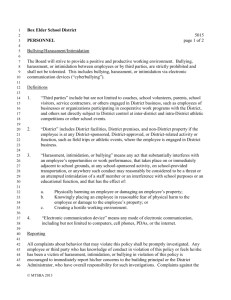

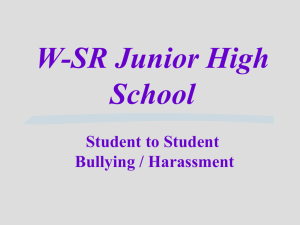
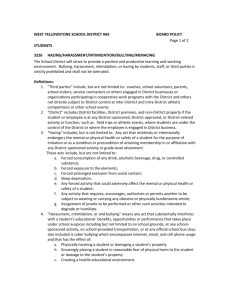


![Bullying and Harassment Advisor role des[...]](http://s3.studylib.net/store/data/006976953_1-320eb77689e1209d082c9ec2464350ee-300x300.png)
